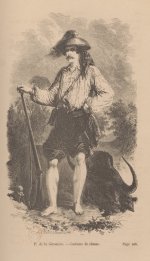Taphrospilus
Well-known member
Ptilinopus leclancheri gironieri (J. Verreaux & Des Murs, 1862) OD here and plate
Palæornis Gironnieri J. Verreaux, J & E. Verreaux, 1853 OD here
The Eponym Dictionary of Birds
The Key to Scientific Names
Ok we can find him here:
Born: 17. August 1797 in Vertou, Loire-Atlantique, Pays de la Loire, France
Death: 23. March 1862 Calauan, Laguna, Calabarzon, Philippines
I checked him only for additional names but in his birth record here p. 15 of 58 I could not identify an additional name. I woluld have expected something like 30 Fructidor année V. but it must be something like a Jour complémentaire which I am actually to stupid to interpret (and not 100% sure what's written there).
So not really news, but I though I share the birth record.
Cette espèce, qui a été envoyée de Tallawan (Philippines) en 1861, par notre ami De la Gironière, a beaucoup d'analogie avec le L. gularis;
Falco Gironnierii Eydoux & Souleyet, 1841 OD here and plateNous a dédions à M. De la Gironière comme un hommage de l'intérêt qu'il porte à la science.
Palæornis Gironnieri J. Verreaux, J & E. Verreaux, 1853 OD here
The Eponym Dictionary of Birds
Black-chinned Fruit Dove ssp. Ptilinopus leclancheri gironieri J. Verreaux & Des Murs, 1862
Dr Paul Proust de la Gironière (1797–1862) was a French physician resident in the Philippines (1820–1861), where he was a pioneering agriculturist. He founded the town Breton aux Îles Philippines (1855).
The Key to Scientific Names
Dr Paul Proust de la Gironnière (1797-1862) French physician resident in the Philippines 1833-1861, founder of the town of Jalajala (syn. Microhierax erythrogenys, syn. Psittacula calthorpae, subsp. Ramphiculus leclancheri).
Ok we can find him here:
Born: 17. August 1797 in Vertou, Loire-Atlantique, Pays de la Loire, France
Death: 23. March 1862 Calauan, Laguna, Calabarzon, Philippines
I checked him only for additional names but in his birth record here p. 15 of 58 I could not identify an additional name. I woluld have expected something like 30 Fructidor année V. but it must be something like a Jour complémentaire which I am actually to stupid to interpret (and not 100% sure what's written there).
So not really news, but I though I share the birth record.
Last edited:





